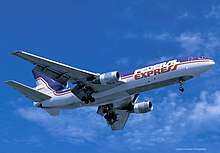FedEx Flight 1406
FedEx Flight 1406 was an American domestic cargo flight from Memphis International Airport, Memphis, Tennessee, to Logan International Airport in Boston, Massachusetts, that suffered an in-flight cargo fire over New York on September 5, 1996. The three crew members and two passengers on board successfully evacuated after an emergency landing at Stewart International Airport in New Windsor, New York. After the evacuation, the DC-10 was consumed by fire. After an extensive investigation, the National Transportation Safety Board was unable to determine what caused the fire. Nevertheless, the Federal Aviation Administration made recommendations to prevent similar incidents from occurring in the future.
 The aircraft involved, April 1996 | |
| Incident | |
|---|---|
| Date | September 5, 1996 |
| Summary | In-flight fire in cargo hold |
| Site | Stewart International Airport, New Windsor, New York 41°30.25′N 74°06.29′W |
| Aircraft | |
| Aircraft type | McDonnell Douglas DC-10-10F |
| Operator | FedEx |
| IATA flight No. | FX1406 |
| ICAO flight No. | FDX1406 |
| Call sign | FEDEX 1406 |
| Registration | N68055 |
| Flight origin | Memphis International Airport, Memphis, Tennessee |
| Destination | Logan International Airport, Boston, Massachusetts |
| Occupants | 5 |
| Passengers | 2 |
| Crew | 3 |
| Fatalities | 0 |
| Survivors | 5 (all) |
Aircraft
The aircraft involved was a McDonnell Douglas DC-10-10F, registered as N68055; it first flew in 1975, and after service with another operator joined the FedEx fleet in 1980.[1]
Crew
There were three crew members and two passengers on Flight 1406. The Captain was a 47-year-old male, with 12,344 flight hours, the First Officer was a 41-year-old male, with 6,535 flight hours and the Flight Engineer was a 45-year-old male, with 3,704 flight hours. Also on board were two FedEx employees sitting in jumpseats.[1]
Flight
Flight 1406 departed from Memphis International Airport at 3:42am, en route to Logan International Airport, Boston, Massachusetts, with an estimated time of arrival (ETA) of 7:42am.[2][1]
At 5:42am, Flight 1406 was cruising at 33,000 ft (10,000 m) above the state of New York when the Cabin Smoke Fire Alarm sounded in the cockpit. Smoke detectors for several zones of the aircraft's main deck cargo compartment alerted the pilots of suspected smoke, prompting the crew members and passengers to don their smoke masks. Aircraft systems began to fail and the crew also noticed that smoke was entering the cockpit. The crew informed Boston Air Traffic Control (ATC) about the fire situation; ATC suggested that Flight 1406 could make an emergency landing at Albany County Airport, 50 mi (80 km) ahead, or to land at Stewart International Airport in New Windsor, 25 mi (40 km) behind. The crew decided to land at Stewart.
At 5:49am the aircraft was on approach to Stewart International Airport, where airport fire services prepared for the DC-10 to land on Runway 27. The aircraft successfully landed at the airport at 5:54am and turned onto a taxiway, where it came to a stop for the fire services to engage. The crew and the employees tried to evacuate the aircraft, but the doors and cockpit windows could not be opened because the fuselage was still pressurized. The captain then de-pressurized the aircraft and all occupants then exited safely; the flight crew through a cockpit window and the passengers through one of the forward fuselage cabin doors. The fire crews found the cargo prevented them from accessing the source of the smoke from inside the cabin and forty minutes after the aircraft landed the fire burned through the fuselage skin; the fire was extinguished four hours after the aircraft landed.[3] All five people on board survived, though two members of the flight crew received minor injuries.
Investigation
Because the fire damage was extensive, a National Transportation Safety Board (NTSB) investigation was unable to find a source of ignition. On 22 July 1998, the NTSB released its report, concluding, "the probable cause of this accident was an in-flight cargo fire of undetermined origin".[4]
References
- "After Smoke Detected in Cargo Compartment Crew Lands DC-10 Then Fire Destroys Aircraft" (PDF). flightsaftey.org. Flight Safety Foundation. Retrieved April 7, 2020.
- "Fedex 1406 CVR Transcript". www.tailstrike.com. Retrieved May 29, 2020.
- Ranter, Harro. "ASN Aircraft accident McDonnell Douglas DC-10-10CF N68055 Newburgh-Stewart Airport, NY (SWF)". aviation-safety.net. Aviation Safety Network. Retrieved May 29, 2020.
- "In-flight Fire/Emergency Landing, Federal Express Flight 1406, Stewart International Airport, Newburgh, New York, September 5, 1996" (PDF). www.ntsb.gov. National Transportation Safety Board. July 22, 1998. NTSB/AAR-98/03. Retrieved May 29, 2020.